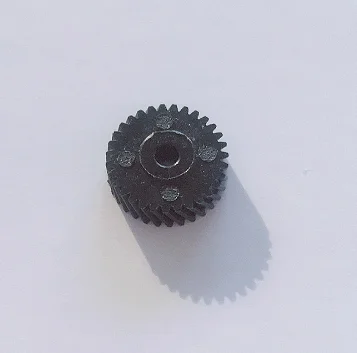Engineers and designers can’t view plastic material gears as just metal gears cast in thermoplastic. They need to pay attention to special issues and considerations unique to plastic gears. Actually, plastic gear style requires attention to details that have no effect on metal gears, such as for example heat build-up from hysteresis.
The essential difference in design philosophy between metal and plastic gears is that metal gear design is founded on the strength of an individual tooth, while plastic-gear design recognizes load sharing between teeth. Put simply, plastic teeth deflect more under load and pass on the strain over more teeth. In most applications, load-sharing escalates the load-bearing capability of plastic material gears. And, consequently, the allowable tension for a specified number-of-cycles-to-failure raises as tooth size deceased to a pitch of about 48. Little increase sometimes appears above a 48  pitch because of size effects and other issues.
pitch because of size effects and other issues.
In general, the next step-by-step procedure will generate an excellent thermoplastic gear:
Determine the application’s boundary circumstances, such as temp, load, velocity, space, and environment.
Examine the short-term materials properties to determine if the initial performance levels are sufficient for the application.
Review the plastic’s long-term home retention in the specified environment to determine whether the performance levels will be preserved for the life of the part.
Calculate the stress levels caused by the many loads and speeds using the physical house data.
Evaluate the calculated values with allowable pressure amounts, then redesign if had a need to provide an sufficient safety factor.
Plastic material gears fail for most of the same reasons metallic types do, including wear, scoring, plastic flow, pitting, fracture, and fatigue. The reason for these failures is also essentially the same.
The teeth of a loaded rotating gear are subject to stresses at the root of the tooth and at the contact surface area. If the gear is  certainly lubricated, the bending stress is the most important parameter. Non-lubricated gears, on the other hand, may degrade before a tooth fails. Therefore, contact stress may be the prime factor in the design of these gears. Plastic gears will often have a full fillet radius at the tooth root. Therefore, they aren’t as prone to stress concentrations as metal gears.
certainly lubricated, the bending stress is the most important parameter. Non-lubricated gears, on the other hand, may degrade before a tooth fails. Therefore, contact stress may be the prime factor in the design of these gears. Plastic gears will often have a full fillet radius at the tooth root. Therefore, they aren’t as prone to stress concentrations as metal gears.
Bending-tension data for engineering thermoplastics is founded on fatigue tests work at specific pitch-line velocities. As a result, a velocity factor ought to be found in the pitch collection when velocity exceeds the check speed. Constant lubrication can raise the allowable tension by one factor of at least 1.5. Much like bending stress the calculation of surface area contact stress requires a number of correction factors.
For example, a velocity aspect is used when the pitch-line velocity exceeds the check velocity. In addition, a factor is utilized to account for changes in operating temperature, gear components, and pressure position. Stall torque is another factor in the design of thermoplastic gears. Frequently gears are at the mercy of a stall torque that’s significantly higher than the standard loading torque. If plastic material gears are run at high speeds, they become vulnerable to hysteresis heating which might get so serious that the gears melt.
There are several approaches to reducing this type of heating. The favored way is to reduce the peak stress by increasing tooth-root region available for the mandatory torque transmission. Another strategy is to lessen stress in the teeth by increasing the apparatus diameter.
Using stiffer components, a materials that exhibits much less hysteresis, can also prolong the operational existence of plastic-type gears. To increase a plastic’s stiffness, the crystallinity levels of crystalline plastics such as for example acetal and nylon could be increased by processing techniques that increase the plastic’s stiffness by 25 to 50%.
The most effective method of improving stiffness is by using fillers, especially glass fiber. Adding glass fibers increases stiffness by 500% to 1 1,000%. Using Agricultural Gearbox fillers does have a drawback, though. Unfilled plastics have exhaustion endurances an order of magnitude higher than those of metals; adding fillers decreases this benefit. So engineers who want to use fillers should take into account the trade-off between fatigue life and minimal temperature buildup.
Fillers, however, perform provide another benefit in the ability of plastic gears to resist hysteresis failure. Fillers can increase temperature conductivity. This helps remove heat from the peak stress region at the bottom of the gear teeth and helps dissipate warmth. Heat removal is the various other controllable general element that can improve level of resistance to hysteresis failure.
The encompassing medium, whether air or liquid, has a substantial influence on cooling rates in plastic gears. If a fluid such as an essential oil bath surrounds a gear instead of air, warmth transfer from the gear to the natural oils is usually 10 instances that of heat transfer from a plastic gear to surroundings. Agitating the essential oil or air also boosts heat transfer by one factor of 10. If the cooling medium-again, air or oil-is definitely cooled by a high temperature exchanger or through style, heat transfer increases a lot more.